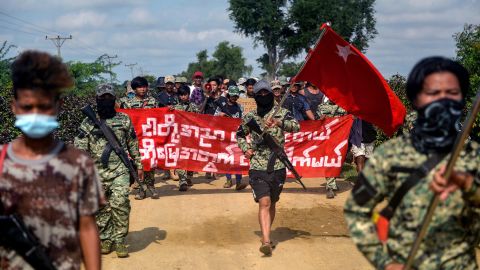CNN
—
Content warning: This story contains descriptions of violence against children and images viewers may find disturbing.
Bhone Tayza had been impatient to start school. A broken arm had kept the 7-year-old home while the other kids began their lessons, but now that his cast was off, he couldn’t wait to join in.
His mother, Thida Win, was still worried. “Just stay home for today,” she recalls telling her son on his third day back at school last September – but he went anyway.
Hours later, the airstrike hit.
Thida Win was home, in the central Sagaing region of Myanmar, when army helicopters began firing “heavy weapons” including machine guns near her house, she said. She took cover until the shooting stopped, then sprinted to the nearby school, frantic. She finally found Bhone in a classroom, barely alive in a pool of blood, next to the bodies of other children.
“He asked me twice, ‘Mom, please just kill me,’” she said. “He was in so much pain.” Surrounded by armed soldiers of Myanmar’s military who had swarmed the school grounds, she pulled Bhone into her lap, praying and doing her best to comfort him until he died.
He was one of at least 13 victims, including seven children, in the September attack – and among the thousands killed nationwide since the military seized power in a coup on February 1, 2021.
The junta ousted democratically elected leader Aung San Suu Kyi, who was later sentenced to 33 years in jail during secretive trials; cracked down on anti-coup protests; arrested journalists and political prisoners; and executed several leading pro-democracy activists, drawing condemnation from the United Nations and rights groups.
Two years on, the Southeast Asian country is being rocked by violence and instability. The economy has collapsed, with shortages of food, fuel and other basic supplies.
Deep in the jungle, rebel groups have taken the fight to the military. Among their number are many teenagers and fresh graduates, whose lives and ambitions have been upended by a war with no end in sight.
For months after the coup, millions across Myanmar took part in protests, strikes and other forms of civil disobedience, unwilling to relinquish freedoms won only recently under democratic reforms that followed decades of brutal military rule.
They were met with a bloody crackdown that saw civilians shot in the street, abducted in nighttime raids and allegedly tortured in detention.
CNN has reached out to Myanmar’s military for comment. It has previously claimed in state media it is using the “least force” and is complying with “existing law and international norms.”
Since the coup, at least 2,900 people in Myanmar have been killed by junta troops and over 17,500 arrested, the majority of whom are still in detention, according to advocacy group Assistance Association for Political Prisoners (AAPP).

Though mass protests have faded, allegations of atrocities by military troops – including the school strike in the village of Let Yet Kone – continue to emerge.
Daw Aye Mar Swe, a teacher at the school, said she ushered students into classrooms as the military helicopters approached, shortly before the horror descended.
The airstrike hit the roof, sending debris falling all around them. The room filled with dark smoke – and then the soldiers arrived.
They began “shooting at the school for an hour nonstop … with the intention to kill us all,” she told CNN.
She shoved her students under beds for cover, but it was of little use. One young girl was shot in the back. As she tried in vain to stem the bleeding, she urged her crying students: “Say a prayer, as only God can save us now.”
When the shooting was over, the soldiers ordered everybody outside, she said. The students huddled together on the school grounds while the soldiers raided the rest of the village and made arrests, said Daw Aye Mar Swe. She recalled seeing Bhone Tayza among the wounded.
The National Unity Government (NUG), Myanmar’s shadow administration of ousted lawmakers, said 20 students and teachers were arrested after the airstrikes.
It’s not clear what happened to them. CNN could not independently verify details of the incident.
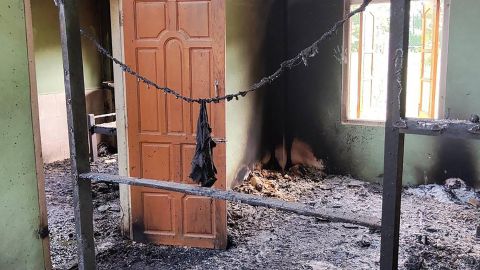
At the time, a spokesperson for the military said government forces entered the village of Let Yet Kone to clear rebel “terrorists” and accused the Kachin Independence Army, a rebel group, and the People’s Defence Force (PDF), an umbrella organization of armed guerrillas, of using children as “human shields.”
Thida Win and Daw Aye Mar Swe denied these claims. “There is no PDF here, or shooting (done by the PDF),” the teacher said. “(The military) shoot us without any purpose or research.”
For some bereaved parents, the agony of losing their children was compounded by being denied a proper goodbye.
After the strike, two residents, who declined to be identified due to fears for their security, said the military took the bodies away and buried them in another township several miles away.
Thida Win corroborated this account, saying she had cried and begged the soldiers to “let me bury my son on my own … but they took him away.” When she contacted a military commander the next day, he said Bhone had already been cremated. To this day, she has not collected his ashes, saying she would not sign any documents issued by the junta that killed her son.
“There are no words … my heart is broken into pieces,” she said.

In between these large-scale attacks, smaller battles are unfolding every day between the military and rebel groups that have sprouted up across the country, allying themselves with long-established ethnic militias.
Some of these groups effectively control parts of Myanmar out of the junta’s reach – and many are composed of young volunteers who left behind families and friends, for what they say is the future of their nation.
Shan Lay, 20, was a high school senior when the coup took place. Now, he spends his days on the front lines as a member of the MoeBye PDF Rescue Team, a small group of combat medics that treats and evacuates injured PDF fighters in eastern Myanmar.
It can be a dangerous job; Shan Lay recalled one instance when their vehicle was shot at and destroyed by military soldiers, forcing the team to jump from the car and run to safety.
Another member of the rescue team, Rosalin, a former nurse, described once hiding in what was supposed to be a secret clinic. The building had been surrounded by junta soldiers and aircraft were circling overhead, so the team waited for nightfall so they could escape in the dark. “I thought I was going to die, and I was ready to relinquish my life,” she said.
CNN is referring to Shan Lay and Rosalin by their “revolution names,” aliases many in the resistance movement adopt for their safety.
Videos of their daily operations, shared by the rescue team, reveal improvised tools and treacherous conditions. Often, they wear no helmets or protective gear, ducking gunfire in just flip flops, t-shirts, long pants and backpacks.
The clips show the group carrying injured fighters on rocky dirt paths, and providing medical care during bumpy rides on pickup trucks; sometimes they have nothing more than boiled water to sterilize wounds, Rosalin said.
When the fighting lulls, they treat injured civilians displaced from their homes and distribute food.

Their jobs are made more difficult by the remote terrain, choppy telecommunications, and unpredictable dangers. When they spoke to CNN over Zoom in January, they had hiked to a higher altitude for better phone service, and were running late after responding to a PDF fighter who had lost his foot after stepping on a land mine.
Rosalin said the junta left them no choice but to fight back after crushing their peaceful protests.
“We know we may have to give up our lives. But if we don’t fight like this, then we know we won’t get democracy, which is what we want,” she said. “As long as this dictatorship is present and we do not have democracy, this revolution will continue.”
Even those not on the front lines have found other ways to resist; there are underground hospitals and schools operating out of the junta’s view, and people have boycotted goods or services related to the junta.
“It’s a remarkable, remarkable show of courage and determination by people,” said Tom Andrews, the UN Special Rapporteur on the situation of human rights in Myanmar.
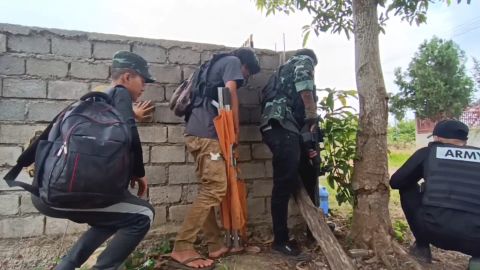
However, despite the rebels’ best efforts, it’s a desperately uneven fight. And after two years of conflict, their funds and resources are dwindling.
“Before, we had our own homes and pots, we had our own rice, we had some of our money,” said Rosalin. “But we had to leave behind our homes and go live in the jungle.” Finding food and accommodation is challenging, she added.
Shan Lay said some people had sold their houses and land to buy weapons and bullets – but it’s still not enough, and a difficult road lies ahead.
The fighting “is more violent” now, he said. “(The junta) are using larger weapons than before.”
Resources are slim in other rebel bases too, with footage from Myanmar’s eastern Karenni state showing uniformed youth training in the mountains, making homemade ammunition in jungle workshops and storing the rounds in refrigerators.
The pictures are a far cry from the military’s powerful arsenal of tanks and warplanes.
The junta demonstrated its devastating firepower just weeks after the school attack with one of its deadliest airstrikes on record.
Crowds had gathered in the A Nang Pa region of Myanmar’s northern Kachin state to celebrate the 62nd anniversary of the Kachin Independence Organization (KIO), the political wing of the rebel Kachin Independence Army (KIA).
Though the event was organized by the KIO, it was aimed at the public, with artists, singers, religious figures and industry leaders invited, according to a businessman who attended. He described a day of festivities, with people bathing in a stream, playing golf and eating noodles under teak trees before watching a musical performance by a famous singer.
When the airstrike happened, “It was like the end of the world,” the businessman said. Footage of the moment of impact, shared with CNN by the KIO, show people sitting around tables facing the stage when there came a dazzling light and loud crash – followed by flashes of orange light, then darkness.
“I heard people crying, speaking and moaning,” said the businessman. “I was standing in a horrific scene.” Bodies appeared to be everywhere; he saw people trapped under debris and some who had lost limbs.
Videos of the aftermath show buildings reduced to rubble and body bags lined up on the ground.
CNN is not naming the businessman for his safety.
The strike killed up to 70 people, according to the KIO. CNN cannot independently verify the number.
When CNN requested comment from the junta regarding the attack, CNN’s email – and an official response – were published in the government-owned Global New Light of Myanmar newspaper. Military spokesperson Maj. Gen. Zaw Min Tun claimed responsibility for the attack, calling it a necessary military operation targeting “a den where enemies and terrorists were hiding.” He also claimed the military had “never attacked civilians,” calling such reports “fake news.”
KIO leaders deny this. They say the venue was a day’s walk from the nearest KIA battalion, and though some KIO members were in uniform at the event, they were not carrying weapons or military equipment.
Andrews, the UN special rapporteur, also cast doubt on the junta’s claim of not striking civilians. “That statement is absurd,” he told CNN in January. “There is clear evidence we have of airstrikes on villages.”
As millions of civilians in Myanmar grapple with their grim post-coup reality, much of the world looks the other way.
“It has been two years of the devastation of the military junta and the military at war with its own people,” Andrews said. “We’ve seen 1.1 million people displaced, more than 28,000 homes destroyed, thousands of people have been killed.”
The economy is in freefall, with Myanmar’s GDP contracting 18% in 2021. While the World Bank forecasts a slight uptick to 3% growth in 2022, some experts say this is “wildly over-optimistic.”
About 40% of the population were living under the poverty line last year, “unwinding nearly a decade of progress on poverty reduction,” the World Bank said last July. Prices for basic goods like food and fuel have skyrocketed.
But little support has come from the outside. The European Parliament passed a motion in 2021 supporting the NUG as “the only legitimate representatives of the democratic wishes of the people of Myanmar,” and it remains one of the few places that has done so. But no military aid has followed.
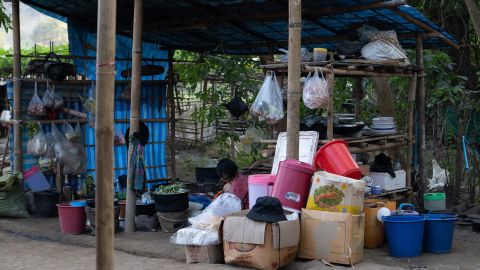
Though the European Union and other governments have provided funding for humanitarian aid, relief remains limited. Groups such as the Red Cross say their operations on the ground have been hindered by fighting and financial challenges. In a December report, the UN Office for the Coordination of Humanitarian Affairs (OCHA) said its response plan for Myanmar was “drastically underfunded,” amounting to $290 million out of the $826 million required.
The conflict “has been forgotten,” Andrews said, contrasting the international community’s muted response to Myanmar versus the rush to provide weapons, funding and other assistance to Ukraine in its war against Russia.
The Ukraine model could be applied to Myanmar, he added – not in terms of importing weapons, but in taking “coordinated actions such as economic sanctions that target the junta’s source of revenue, that target their weapons, that target the raw materials that they’re using to build weapons inside the country.”
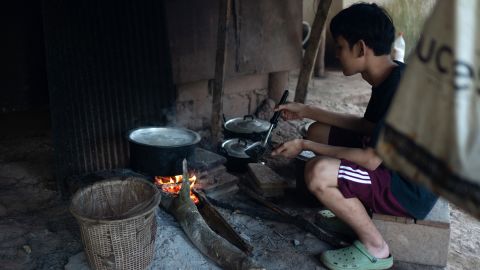
Andrews pointed to signs that the junta is struggling too, which makes international aid all the more critical for turning the tide. There are reports the military controls less than half of the country and that its operations are suffering from financial difficulties, thanks in part to sanctions already in place, he said. But more is still needed.
“If (the conflict) remains in the shadows of international attention, then we are providing a death sentence to untold numbers of people,” Andrews warned.
Thida Win, the mother of Bhone Tayza, had a similar plea. She is still grieving the loss of a son she described as studious, intelligent and kind, for whom she “had so much hope.”
“I want to ask the world to support us so our children’s death will not be in vain,” she said. “Will you just look away from us? How many kids have to risk their lives?”

